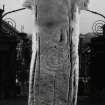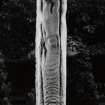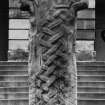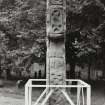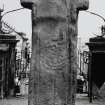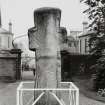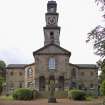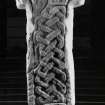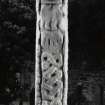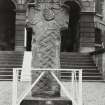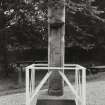Scheduled Maintenance
Please be advised that this website will undergo scheduled maintenance on the following dates: •
Tuesday 3rd December 11:00-15:00
During these times, some services may be temporarily unavailable. We apologise for any inconvenience this may cause.
Hamilton, Hamilton Parish Church, Netherton Cross
Cross (10th Century)
Site Name Hamilton, Hamilton Parish Church, Netherton Cross
Classification Cross (10th Century)
Alternative Name(s) Hamilton Old Parish Church
Canmore ID 45656
Site Number NS75NW 15
NGR NS 72342 55555
NGR Description NS 72341 55555 removed from NS 7271 5674
Datum OSGB36 - NGR
Permalink http://canmore.org.uk/site/45656
- Council South Lanarkshire
- Parish Hamilton (South Lanarkshire)
- Former Region Strathclyde
- Former District Hamilton
- Former County Lanarkshire
Netherton, Lanarkshire, cross
Measurements: H 2.1m above ground, W across side-arms 0.76m, W of shaft 0.46m, D 0.28m
Stone type: red sandstone
Place of discovery: NS 7271 5674
Present location: outside the main entrance to Hamilton Parish Church.
Evidence for discovery: When Stuart recorded the stone in the mid nineteenth century, it stood in the grounds of Hamilton Palace, only 1.52m in height above ground. It was moved to its present position in 1926 and placed on a modern base.
Present condition: there is considerable damage to all the carved faces, and the stone is very weathered.
Description
The slab has been dressed into the shape of a cross with short side-arms, and it is carved in false relief on all four vertical faces, within plain flat-band mouldings.
On face A, the side-arms are accentuated by being filled with raised triangles, each with incised inner triangles, and the centre of the cross has a raised spiral. The upper arm contains a human figure between two beast-headed bipeds, and below them are perhaps two beasts but they are hard to discern. Below the central spiral on the right is a quadruped, but that on the left is defaced. The shaft is filled with heavy median-incised interlace.
Face C bears a central disc from which pairs of serpents extend out into the side-arms. The upper arm contains a short frontal human figure with arms at the sides. Below the disc the carving is much damaged, but a pair of human legs facing left are visible on the right, and below them an ornamented disc on a long vertical stem.
On narrow face B, a human figure within an arch is carved on the upper arm, a panel of lattice work on the end of the side-arm, and an upside down human figure on the side of the shaft, above parallel curving lines. The carving on narrow face D consists of a coiled snake with prominent tongue on the upper arm, another panel of lattice work on the end of the side-arm, and on the shaft a pair of figures above an area too weathered to make out the details.
Date: tenth century.
References: Stuart 1856, pl 118; ECMS pt 3,470-2; Stevenson 1959, 49-51.
Desk-based information compiled by A Ritchie 2019.
NS75NW 15 72341 55555 removed from 7271 5674.
This cross formerly stood in Hamilton Low Parks (at NS 7271 5674) and was moved to its present position in the graveyard of Hamilton Parish Church in 1926. Carved from a slab of local red sandstone, it stands to a height of 2.1m and is dec orated on all four sides. The front bears (from top to bottom) a human figure between two beast-headed humans; a fish; a spiral boss between two panels of geometric carving in the arms of the cross; a panel of interlace in the shaft; and finally, a much weathered four-footed animal. On the rear, there is a squatting human figure above a central boss from which radiate two snake-like bands.
The sides are also decorated: on the right, a beast-headed man and, below the cross-arm, an inverted human figure; on the left, a coiled snake, and, on the shaft, two beast-headed men and an animal with a long jaw. The style of decoration suggests that the cross is rather late, probably dating to the 10th century.
J Stuart 1856; OS 6" map, Lanarkshire, 1st ed. (1864), sheet xi; J R Allen and J Anderson 1903; R B K Stevenson 1961; J B Stevenson 1985
Surveyed at 1:1250 scale.
Visited by OS 4 September 1953.
Non-Guardianship Sites Plan Collection, DC28395, 1942.
Publication Account (1985)
This cross formerly stood in Hamilton Low Parks (NS 727567) close to the site of an early church, and was moved to its present position in 1926. Carved from a slab ofloeal red sandstone, it stands to a height of 2.1m and is decorated on all four sides.
The front bears (from top to bottom) a human figure between two beast-headed humans; a fish; a spiral boss between two panels of geometric earving in the arms of the cross; a panel of interlace in the shaft; and finally, a much weathered four-footed animal. On the rear, there is a squatting human figure above a central boss from which radiate two snake-like bands. The sides are also decorated: on the right, a beast-headed man and, below the cross-arm, an inverted human figure; on the left, a coiled snake, and, on the shaft, two beast-headed men and an animal with a long jaw.
The style of decoration suggests that the cross is rather late, probably dating to the 10th century.
Information from ‘Exploring Scotland’s Heritage: The Clyde Estuary and Central Region’, (1985).
Publication Account (1996)
The Nethertoun Cross figure 6, which now stands in front of the entrance to Hamilton new parish church, was brought to this place for safekeeping in the early twentieth century, but its original site was some 60 m north of the motte. Both the original site and the style of decoration of the stone cross are of interest. Some have argued that the cross was carved in the eighth century, but its decoration suggests that it is more likely to be tenth century at the earliest, and, more probably, eleventh or twelfth. Its location strongly suggests that there was some form of settlement nearby. When allied to the evidence of the motte, it probably confirms the site of first settlement of Cadzow: hence its name, the 'Nethertoun Cross'. Its decoration suggests that it was of religious significance, rather than a secular market cross and there is a tradition that an early church stood nearby, perhaps on land now submerged beneath Strathclyde Loch.
Information from ‘Historic Hamilton: The Archaeological Implications of Development’ (1996).


























































